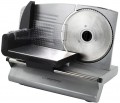Blade diameter
The diameter of the blade of the knife supplied with the slicer. Knives are shaped like discs — accordingly, the diameter of the blade is actually equal to the diameter of the disc.
The larger the blade, the larger ingredients the device can handle at a time and the “larger” the cut slices can be. At the same time, in fact it is rarely necessary to use a slicer for very thick products. Therefore, even in the most “large-caliber” modern models, the knife diameter usually does not exceed 300 mm.
Pulse mode
Possibility of work of a slicer in the
pulse mode. In this mode, in accordance with the name, the knife of the device works nonuniformly — high speed alternates with short pauses. Pulse switching is well suited for working with dense and solid products: it allows you to develop a higher working speed than with uniform work, at the same time it does not allow overloading the knife and reduces the chance of jamming. However, even in such models, there is usually no question of cutting fruit pits or other equally solid ingredients — slicers are not designed for this in principle.
Foldable
The ability
to fold the slicer when it is not in use.
The meaning of folding in slicers is the same as in any other technique — it allows you to reduce the dimensions of the unit and make it more convenient for storage and moving from place to place. However the folding structure is considered less durable and reliable than the unibody; however, in this case, this difference is not fundamental.
Also note that this category also includes such a specific variety as built-in slicers — without the possibility of folding, such devices would be too bulky and would cause inconvenience when embedded.
Material
The main material used in the construction of the slicer.
—
Plastic. This material is characterized by low cost and is often used in inexpensive models. However, its use is not an unambiguous sign that the slicer belongs to the low-cost class. The fact is that although the reliability of plastic is considered relatively low (compared to metal), it is quite sufficient even for fairly powerful models. In addition, there are many varieties of this material on the market, including options with high strength rates. Therefore, the actual strength and reliability of plastic is usually directly dependent on the price category of the slicer.
—
Metal. On the practical side, metal is remarkable for its high strength: it is much more difficult to damage such a body than plastic. In addition, it gives the device a solid appearance. The disadvantage of this material is a higher cost — despite the fact that the real need for the mentioned strength indicators is quite rare.

